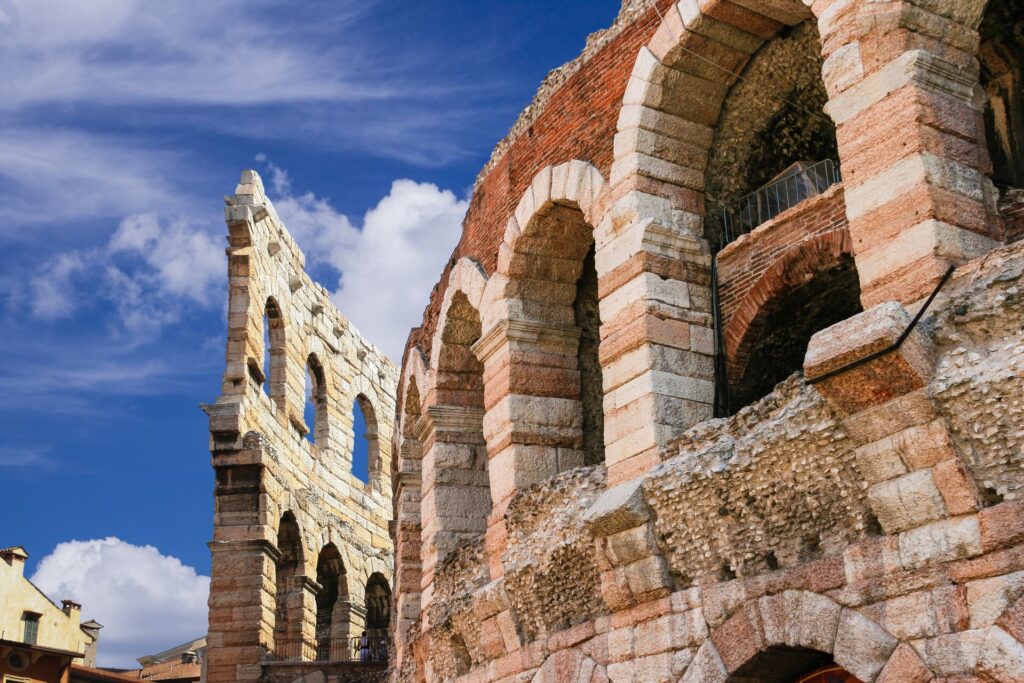Strength and Honor: Gladiator Arenas in Italy You Can Visit
With Gladiator 2 igniting our imaginations, there’s never been a better time to walk in the sandals of ancient warriors and explore the most famous gladiator arenas in Italy. From the grand Colosseum in Rome to hidden gems scattered across the country, these monumental structures whisper tales of courage, spectacle, and history. Let’s uncover their stories, the brutal (and sometimes bizarre) events they hosted, and what the gladiator arenas in Italy symbolize today.
The Colosseum, Rome
Rome’s Colosseum, the largest amphitheater ever built, remains the ultimate symbol of gladiator arenas in Italy. Constructed in AD 80, it hosted deadly games where gladiators fought to the death, sometimes against each other, sometimes against wild animals like lions, leopards, and bears.

But gladiator fights weren’t the only attractions here. Naval battles (naumachiae) were staged when the arena was flooded, and there were also public executions, mythological reenactments, and animal hunts (venationes). Today, as you stroll through its towering arches, it’s easy to imagine the roar of 50,000 spectators chanting, “Strength and honor!”
On any Insightful tour to Italy, you’ll stop by Rome and explore this marvel of Roman engineering. Even better, you’ll have a knowledgable guide and skip-the-queue access as included on every Insight tour.
Verona Arena, Verona
The Verona Arena is a magnificent Roman amphitheater still in use today—though its performances are decidedly less bloody. Built in the 1st century AD, it seated up to 30,000 spectators and was known for its venationes, featuring exotic animals shipped from the far corners of the Roman Empire.
While gladiator fights thrilled the crowd, the arena also hosted grand Roman spectacles, including music, dance, and theatrical productions. Now, it’s renowned for its operatic performances, proving that the stage’s drama has only changed form.

With Insight, you’ll explore Verona’s incredible amphitheater as well as the rest of the romantic city of Shakespeare’s Romeo and Juliet. You can choose to take a walking tour through grand piazzas, see Dante’s statue, and admire the Gothic Scala family tombs, or follow a Shakespeare-themed trail to relive moments from the writer’s famed love story.
Save up to $3,000* per couple on your first Premium Tour
Plus receive latest offers, travel inspiration, and discover how your travels will make a positive impact. Together, WE MAKE TRAVEL MATTER®. Subscribe NowAmphitheater of Pompeii, Pompeii
The Amphitheater of Pompeii is the oldest stone amphitheater in the Roman world, dating back to 70 BC. Its smaller size didn’t diminish its importance, as it was the heart of Pompeii’s entertainment scene.
Gladiatorial fights here were a community affair, with the citizens of Pompeii cheering for their favorites. The amphitheater also hosted lively festivals and games. The eruption and resulting ash of Mount Vesuvius in AD 79 kept this structure hidden from the elements over the years, making this the best preserved of the gladiator arenas in Italy, allowing you to truly step back in time when you visit.

On the Best of Italy tour, you’ll traverse the Italian landmass from one iconic spot to another. On Day 10, you’ll step into ancient history at Pompeii, and see the world’s oldest surviving amphitheater for yourself as you stroll through the town’s cobbled streets with a Local Expert, exploring the Forum, vibrant frescoed villas, and everyday remnants of Roman life.
Lecce, Apulia
Lecce’s Roman amphitheater is a striking reminder of the city’s ancient past, hidden beneath the baroque streets until its accidental discovery in the early 1900s. Unearthed by workers constructing the Bank of Italy, this 2nd-century AD arena had been entirely buried for centuries. Even today, only part of the amphitheater is visible, as much of it remains beneath the modern city. Once capable of holding up to 25,000 spectators for gladiatorial games and public events, it now serves as a cultural hub hosting concerts and performances that echo its storied history.

Syacruse amphitheater, Sicily
Syracuse’s Roman amphitheater is a testament to the grandeur of ancient Rome, designed for thrilling spectacles like gladiatorial combat and animal hunts. Carved directly into the bedrock during the 3rd century AD, it is one of the largest Roman amphitheaters in Sicily. Though partially buried over time, its elliptical structure and remnants of seating still evoke the roaring crowds and high-stakes drama that once filled its arena.

You can explore this incredible site with Insight Vacations on the Sicily in Depth tour. Right next to the Roman amphitheater lies Syracuse’s iconic Greek theater, another architectural marvel carved from solid rock. Dating back to the 5th century BC, this theater hosted dramatic performances and civic ceremonies. Together, these neighboring landmarks offer a fascinating glimpse into the city’s dual Greek and Roman heritage. Your visit continues at the nearby Paradise Quarry and its famous Ear of Dionysius, followed by a tour of Ortygia Island’s atmospheric streets, historic palaces, and the spot where Archimedes is said to have cried “Eureka!”
Life Beyond the Gladiator Games
While gladiators are the headliners, these arenas were multifunctional hubs of Roman life. Politicians held public addresses here to curry favor with citizens, and emperors showcased their wealth and power through extravagant games. Some arenas even hosted religious ceremonies or markets.
Each of these arenas offers a unique window into ancient Rome’s theatrical and violent world. Modern visitors can marvel at the architectural brilliance and learn about the lives of those who fought, cheered, and perished in these stone coliseums.
If Gladiator 2 has you craving the drama of ancient Rome, why not journey to Italy and experience the real arenas where the legend began? Step into history, and as Maximus would say, “Are you not entertained?”
LIKED THIS POST? SHARE WITH YOUR COMMUNITY






